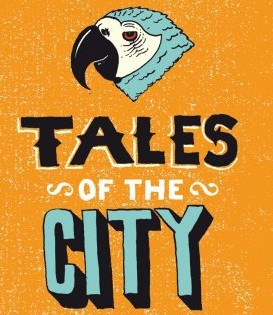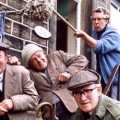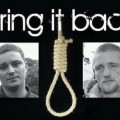The End Is In Sight: Closing The Book On Armistead Maupin's Tales Of The City
Next week, Arimstead Maupin releases the ninth and final book in the Tales of the City series, meaning that fans must prepare to say their final goodbyes to some of literature’s most beloved characters...

There are few things more frustrating than realising the writers of your favourite series are making it up as they go along. Take Lost, for example. Throughout the show’s intermittently brilliant six-year run, its creators maintained that they always knew precisely what was going on, even if its viewers were often none the wiser. So we took them at face value, convinced that all those inexplicable events would eventually coalesce in a climax that made sense of everything. Of course, the reality was somewhat different, leaving millions of viewers feeling cheated and let-down by its ‘throw shit at the wall and see what sticks’ approach to story-telling.
Which makes Armistead Maupin’s singular talent that much more remarkable, not least because of his alarming knack for tying up loose ends, even if the resolutions are several decades in the making. Despite a writing style that compels readers to devour his books like Gilbert Grape’s mother at an all-you-can-eat buffet, Maupin’s stories are quite content to take their time in the telling.
Long-time fans, who by now probably number in the millions, have stayed with him since his long-running Tales of the City series started out as a fictional column for the San Francisco Chronicle. Written to meet a daily deadline, Maupin’s serialisation had no option but to follow the whims of his imagination. As a consequence, his growing legion of followers delighted in seeing where the twisting, turning story would take them. And never once did they ever have cause to question whether the captain knew in advance what icebergs lay ahead. Yet, time and time again, Maupin’s uncanny ability to weave fortuitous coincidence and rug-pulling revelations into a neatly-wrapped narrative, never once let him down. Even now, the books read as though they were all meticulously planned right from the start, despite abundant evidence to the contrary.
During the 1970s, Maupin’s books offered readers a joyous counterpoint to the seedy, crime-ridden underbelly of San Francisco that movie-goers saw in the Dirty Harry series. Bewitched by the free-spiritedness of his newly-adopted home, Maupin depicted San Francisco as a modern-day Shangri La. A bohemian utopia of tolerance and bed-hopping, shrouded in an intoxicating fug of marijuana smoke. As seen through the naïve eyes of secretary Mary Ann Singleton, the city-by-the-bay managed to be both welcoming and intimidating in equal measure – greeting newcomers with a patchouli-scented embrace, only to chide them for having the temerity to serve instant coffee.
Although readers initially joined Mary Ann on her voyage of discovery, hoping that she’d eventually reconcile her prickly demeanour with her more laid-back surroundings, it wasn’t until we met Mrs Madrigal that we discovered the books’ real soul. The eccentric landlady of 28 Barbary Lane, Mrs Madrigal was the permissive, Tennyson-quoting materfamilias who, when asked if she had any objection to pets in her building, replied enigmatically “Dear, I have no objection to anything.”
Over the course of the first book, readers are gradually introduced to a diverse cast, whose sexualities inform and inspire, but never define, their characters. Rereading the books now, there’s a charming innocence to the way this eclecticism was depicted. So it’s easy to overlook just how revolutionary this was back in the 1970s, even for a city as progressive as San Francisco. Making room in his interconnected world for every conceivable sexual identity, Maupin stayed true to his intention that he be defined as a ‘gay author’, rather than a writer of ‘gay fiction’.
This issue hit home for Maupin when the studios came calling in the mid-eighties, with a big screen adaptation in mind. In a 1993 interview with the LA Times, the author recalled how “…a producer who bought the option invited me to dinner one night with the screenwriter he was proposing for it. The writer said how fabulously talented I was, then hit me with the idea that the gay gynaecologist be made into a serial killer.” Another aborted attempt at turning the books into a drama series on CBS encountered similar problems: “They indicated they had no problem with the material until I was minutes away from signing the contract, when they said they might have to eliminate the gay and lesbian characters. As if this was a minor consideration from my viewpoint. I told them taking gay people out of Maupin was like taking poor people out of Dickens.”
Over the years, that literary comparison has become increasingly prescient, as critics approvingly compare Maupin’s output to that of Dickens, where once they were content to dismiss his work as little more than a well-written soap opera. Initially, perhaps, such a reductionist assessment might have been appropriate, since the storylines relied heavily on contrivance and coincidence. But as the carefree spirit of the 70s gave way to the materialistic narcissism of the 80s, and the spectre of AIDS loomed large over the city’s gay community, the storylines matured accordingly. Although many of the characters retained their irrepressible joie de vivre, the tone inevitably grew darker and the plotlines more dramatic.
More…
Even so, Maupin’s decision to prematurely end the series with Sure Of You in 1989, left fans grieving for their fictional friends. Minimal concessions were made by allowing some of his peripheral characters to make cameo appearances in Maybe The Moon and The Night Listener, but it was clear that there was still life in the old dogs yet. When Maupin published Michael Tolliver Lives in 2007, he stressed that, although he was keen to catch up with his old friends, this was in no way to be seen as the seventh Tales instalment. Thankfully, 2010’s Mary Ann in Autumn came with no such caveat, and even managed the not-inconsiderable achievement of wrapping up a storyline that had been left open for over 30 years.
Sadly, nothing can last forever. Next week, Maupin releases the ninth and final book in the Tales of the City series, meaning that fans must prepare to say their final goodbyes to some of literature’s most beloved characters. In the Days of Anna Madrigal, the irrepressible nonagenarian takes a final road trip to Winnemucca; site of the whorehouse where she was raised.
It all seems a far cry from the carefree hedonism and youthful adventures of the early books in the series, but then Maupin has never shied away from defying description. Even if that means breaking with his own well-established conventions. He never wanted his books to be relegated to the ‘gay literature’ shelf, giving booksellers the challenge of attempting to categorise his unique style. Many of the Tales have an unmistakable mystery thriller structure, but wouldn’t sit comfortably alongside police procedurals or grisly whodunits. Likewise, they’re unashamedly sentimental, but have a tart and pithy humour seldom found in more conventional romances. Instead, what we’re left with is a series of carefully constructed stories that blend farcical elements like adultery, illegitimate babies and secret identities, with more hard-hitting concepts such as paedophilia, cannibalistic rituals and terminal illness.
Ultimately though, the secret of the books’ appeal, lies in what Maupin’s characters refer to as the ‘logical family’. These are the friends and loved ones we gravitate towards, as we move away from our biological families and define ourselves on our own terms. Free from hereditary obligation and expectation, these are the people we choose to spend our lives with. As the old saying goes, you can pick your friends but you can’t pick your family. In Maupin’s universe, the path to happiness involves the best of both worlds.
When I visited San Francisco a couple of years ago, the holiday became something of an extended pilgrimage, as we trekked from location to location, attempting to track down as many of the book’s landmarks as we could find. And although we managed to find the rickety wooden steps in Russian Hill which led to Anna Madrigal’s house, we soon discovered that there’s really no such place as 28 Barbary Lane. But that’s the real message at the heart of Maupin’s tales – it’s up to each of us to find our own.
Click here for more stories about Books
Click here to follow Sabotage Times on Twitter
Click here to like Sabotage Times on Facebook
If you like it, Pass it on
 COMMENTS
COMMENTS
Great piece, Gareth, but isn't he the chap that fucked up the Zodiac investigation?
No Paul avery u are thinking of
Hello- I just read your article, and found it to pinpoint the authorship of Mr. Maupin to a "T". Myself, a resident of San Francisco, am drawn to his characters as if they were members of my nuclear family. It's noteworthy Maupin's tales continue without advance knowledge as to how things unfold, and for this reason I hope their is never an ending so to speak. We in San Francisco who read and re-read his works are devoutly loyal and eternally grateful. Thanks.


 RELATED
RELATED










